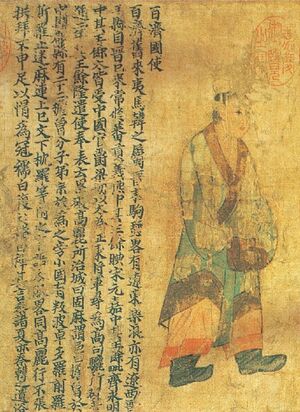پكتشى
| ||||||||||||||||||||||||||||||||||||||||||||||||||||||||||||||
| ||||||||||||||||||||||||||||||||||||||||||||||||||||||||||||||
پكتشى (Baekje ؛ بالكورية: 백제; 百濟; [pɛk̚.t͈ɕe] Middle Chinese: [pˠæk̚.t͡seiH] Go-On: النطق الياباني: [ça̠kɯ̟ᵝsa̠i]) also called Nambuyeo (Korean: 남부여; 南扶餘 [na̠m.pu.jʌ̹] Middle Chinese: [nʌm.bɨo.jɨʌ] Go-On: النطق الياباني: [nàńbɯ̟ᵝjo̞]), was a Korean kingdom located in southwestern Korea from 18 BC[1] – 660 AD. It was one of the Three Kingdoms of Korea, together with Goguryeo and Silla.
Baekje was founded by Onjo, the third son of Goguryeo's founder Jumong and So Seo-no, at Wiryeseong (present-day southern Seoul). Baekje, like Goguryeo, claimed to succeed Buyeo, a state established in present-day Manchuria around the time of Gojoseon's fall.
Baekje alternately battled and allied with Goguryeo and Silla as the three kingdoms expanded control over the peninsula. At its peak in the 4th century, Baekje controlled most of the western Korean peninsula, as far north as Pyongyang, and may have even held territories in China, such as in Liaoxi, though this view is controversial. It became a significant regional sea power, with political and trade relations with China and Japan.
Baekje was a great maritime power;[3] its nautical skill, which made it the Phoenicia of East Asia, was instrumental in the dissemination of Buddhism throughout East Asia and continental culture to Japan.[4][5]
In 660, it was defeated by Tang Dynasty, and submitted to Unified Silla.
التاريخ

العلاقات الخارجية
العلاقات مع الصين
 Ambassador of Baekje at the Chinese court of Emperor Yuan of Liang in his capital Jingzhou in 516–520 CE, with explanatory text. Portraits of Periodical Offering of Liang, 11th century Song copy. |
In 372, King Geunchogo paid tribute to the Jin Dynasty of China, located in the basin of the Yangtze River. After the fall of Jin and the establishment of Song Dynasty in 420, Baekje sent envoys seeking cultural goods and technologies.
Baekje sent an envoy to Northern Wei of Northern Dynasties for the first time in 472, and King Gaero asked for military aid to attack Goguryeo. Kings Muryeong and Seong sent envoys to Liang several times and received titles of nobility.
Tomb of King Muryeong is built with bricks according with Liang's tomb style.
العلاقات مع اليابان

الوقع الثقافي والدعم العسكري
سقوط پكتشى والدعم العسكري من اليابان

ذكراها
انظر أيضاً
الهامش
- ^ أ ب "Korea, 1–500 A.D.". In Heilbrunn Timeline of Art History. New York: The Metropolitan Museum of Art, 2000–. Korea, 1–500 A.D. at the Wayback Machine (archived 2015-11-14) (October 2000)
- ^ Iryeon (1281). Samgungnyusa.
- ^ Ebrey, Patricia Buckley; Walthall, Anne; Palais, James B. (2006). East Asia: A Cultural, Social, and Political History (in الإنجليزية). Houghton Mifflin. p. 123. ISBN 9780618133840. Retrieved 12 September 2016.
- ^ Kitagawa, Joseph (2013-09-05). The Religious Traditions of Asia: Religion, History, and Culture (in الإنجليزية). Routledge. p. 348. ISBN 9781136875908. Archived from the original on 3 December 2016. Retrieved 29 July 2016.
- ^ Ebrey, Patricia Buckley; Walthall, Anne; Palais, James B. (2013). East Asia: A Cultural, Social, and Political History, Volume I: To 1800 (in الإنجليزية). Cengage Learning. p. 104. ISBN 978-1111808150. Archived from the original on 3 December 2016. Retrieved 12 September 2016.
للاستزادة
- Best, Jonathan W. A History of the Early Korean Kingdom of Paekche, together with an annotated translation of "The Paekche Annals" of the "Samguk sagi" (Harvard East Asian Monographs, 2007).
وصلات خارجية
 Media related to پكتشى at Wikimedia Commons
Media related to پكتشى at Wikimedia Commons- Baekje History & Culture Hall maintained by South Chungcheong Province of South Korea
- Buyeo National Museum
- Gongju National Museum
- Short description is different from Wikidata
- Former country articles categorised by government type
- Articles containing كورية-language text
- Articles containing Korean-language text
- Articles with hatnote templates targeting a nonexistent page
- پكتشى
- شعوب قديمة
- Former countries in East Asia
- Former countries in Korean history
- تاريخ كوريا
- تأسيسات 18 ق.م.
- انحلالات 660
- ممالك كوريا الثلاث
- دول وأقاليم تأسست في القرن الأول ق.م.
- دول وأقاليم انحلت في 660

